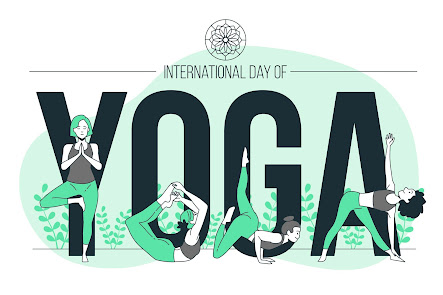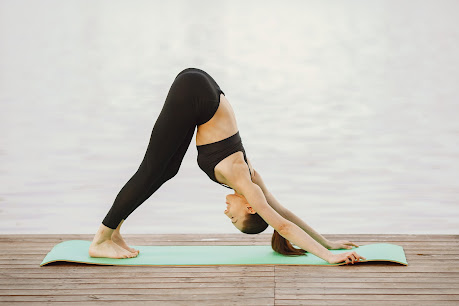Fit for Life: Habits and Mindset for Sustainable Fitness and
Wellness
Introduction:
Staying fit and healthy is not just about going to the gym
or following a diet plan for a few weeks. It is about adopting a sustainable
lifestyle that promotes physical, mental, and emotional wellness.
To truly
achieve sustainable fitness and wellness, it is important to cultivate healthy
habits and develop a positive mindset. This article will explore some of the
key habits and mindsets that can help you stay fit and healthy for life.
You
are certain to gain some useful insights from this article, whether you are a
seasoned athlete or just starting out on your fitness journey.
1. Set
Realistic Goals:
Setting
realistic goals is essential for sustainable fitness and wellness. It is
important to set goals that are challenging but achievable, and align with your
overall vision for your health and well being.
For instance, on the off chance
that you want to get thinner, it is critical to set a practical objective that
considers your ongoing weight, way of life, and generally well being.
Setting
unrealistic goals can lead to frustration, disappointment, and even injury, but
by setting realistic goals, you can measure your progress and celebrate your
successes, which can help keep you motivated and on track.
Therefore, devote
some time to contemplation of your desired outcomes and the establishment of
attainable objectives that will assist you in achieving them..
2. Create a
Routine:
Creating
a routine is essential for sustainable fitness and wellness. It helps you
establish healthy habits and makes it easier to stick to your goals.
It should
include regular exercise, healthy eating, stress management techniques, and
getting enough sleep. By creating a routine, you can develop a sense of
discipline and consistency, which can help you stay on track even when life
gets busy.
Additionally, having a routine can help you stay motivated and
accountable, as you have a clear plan for what you need to do each day to work
towards your goals.Therefore, devote some time to developing a routine that is
effective for you and make it a daily habit to adhere to it.
3. Prioritize
Sleep:
Sleep
is essential for overall health and well-being. Prioritizing sleep means getting
at least seven hours of sleep every night and creating a sleep-friendly
environment.
Sleep deprivation can impair immune system function, reduce
cognitive function, and raise stress levels. To prioritize sleep, it is
important to establish a regular sleep schedule and create a relaxing bedtime
routine.
It is also important to create a sleep-conducive environment, such as
keeping your bedroom cool, dark, and quiet.
You can help yourself feel more energized and focused
throughout the day by giving your body the time it needs to rest, repair, and
rejuvenate by making sleep a priority.. So make sure to get enough sleep each
night, and make it a priority in your daily routine.
4. Focus on
Nutrition:
Nutrition is essential for sustainable fitness and wellness.
It is vital to eat a reasonable eating regimen that incorporates different
entire, supplement thick food varieties like organic products, vegetables,
entire grains, lean protein, and solid fats.
Additionally, it is important to
pay attention to portion sizes and avoid processed and high-calorie foods that
can contribute to weight gain and other health issues. It is also a good idea
to stay hydrated by drinking plenty of water throughout the day.
You will be
able to provide your body with the nutrients it needs to perform at its best,
both physically and mentally, if you focus on nutrition.
5. Incorporate
Strength Training:
Strength training is an essential part of any fitness
routine. It helps build muscle, boost metabolism, and improve overall fitness.
It is important to start with a program that matches your fitness level and
goals, and gradually increase the weight and intensity over time.
Effective
strength training exercises include weightlifting, resistance band workouts,
and body weight exercises such as push-ups and squats.You can develop a body
that is more able to withstand the stresses of everyday life by incorporating
strength training into your exercise routine.
So make sure to include strength
training in your exercise program, and make it a habit to challenge yourself
and push your limits.
6. Practice
Mindfulness:
Mindfulness is a powerful tool for improving mental health
and reducing stress. It involves paying attention to thoughts, feelings, and
surroundings in the present moment without judgment.
It can help reduce stress,
improve mental clarity, and increase feelings of calm and well being. Effective
mindfulness practices include meditation, deep breathing exercises, and mindful
movement practices such as yoga and tai chi.
Finding a training that works for
yourself and make it a normal piece of your routine is significant. By
rehearsing care, you'll be better ready to oversee pressure, work on mental and
close to home well-being, and keep fixed on your objectives.
7. Find a
Support System:
Having a support system is essential for sustainable fitness
and wellness. It can help keep you accountable, provide feedback and advice,
and offer encouragement when you need it most. It is essential to find
individuals who share your objectives and values, and who will uphold you in
accomplishing them.
By building a strong support system, you'll be better
equipped to overcome challenges, stay motivated, and achieve long-term success.
Reach out to others who can support you in your journey, and make it a habit to
surround yourself with positive and supportive people.
8. Stay
Consistent:
Consistency is key when it comes to sustainable fitness and
wellness. It is important to establish healthy habits that can maintain over
the long term, rather than engaging in short-term, unsustainable behavior.
It is
also important to have a plan in place for how to manage obstacles and
setbacks, such as scheduling workouts in advance, preparing healthy meals in
advance, and finding alternative ways to stay active when your usual routine is
disrupted.
By staying consistent, you will be able to make steady progress
towards your goals and build healthy habits that will last a lifetime. So make
it a habit to prioritize fitness and wellness in your daily life, and stay
committed to your goals even when it's challenging.
9. Embrace
Change:
Embracing change is essential for sustainable fitness and
wellness. It means being open to new ideas, trying new things, and learning
from your experiences.
It also means being flexible and willing to adjust your
goals and plans as needed. By embracing change, you'll be better equipped to
overcome obstacles, stay motivated, and continue making progress towards your
goals.
Make it a habit to stay open to new experiences and ideas, and embrace
change as an opportunity for growth and improvement.
10. Celebrate
Small Wins:
Celebrating small wins is an important part of staying
motivated and committed to fitness and wellness goals. It involves
acknowledging progress, no matter how small, and using it as motivation to keep
going.
Examples of ways to celebrate small wins include rewarding yourself with
a healthy treat, treating yourself to a relaxing activity, or simply taking a
moment to acknowledge your progress and appreciate your hard work.
By
celebrating small wins, you'll be better equipped to maintain motivation and
continue making progress towards your long-term goals. So make it a habit to
acknowledge and celebrate the small milestones along the way, and use them as
motivation to keep moving forward.
Conclusion:
Staying fit for life requires a combination of habits and
mindset that promote physical, mental, and emotional wellness.
By setting
realistic goals, creating a routine, prioritizing sleep, focusing on nutrition,
incorporating strength training, practicing mindfulness, finding a support
system, staying consistent, embracing change, and celebrating small wins, you
can create a sustainable approach to fitness and wellness that will last a
lifetime.
Remember that staying healthy and fit is more than just looking good;
Additionally, they are about having fun, being healthy, and feeling good.Make
it a priority to take care of yourself, and use the habits and mindset outlined
in this article to achieve sustainable fitness and wellness for the long term.








%20%E2%80%A2%20Instagram%20photos%20and%20videos.png)
%20%E2%80%A2%20Instagram%20photos%20and%20videos.png)
























.jpg)














